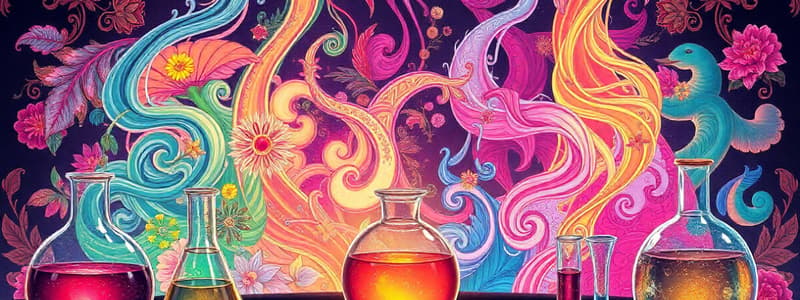Podcast
Questions and Answers
Which option describes an action that does not result in a yellow color?
Which option describes an action that does not result in a yellow color?
- Adding a solution of silver nitrate to a sodium phosphate solution (correct)
- Adding dilute hydrochloric acid to sodium sulfite salt
- Adding dilute hydrochloric acid to potassium thiosulfate salt
- Passing bromine vapor through a starch solution
Which action creates a yellow color in all the given cases except one?
Which action creates a yellow color in all the given cases except one?
- Passing bromine vapor through starch
- Adding HCl to potassium thiosulfate salt
- Mixing copper sulfate with sodium chloride (correct)
- Adding HCl to sodium sulfite salt
Which of the following actions is least likely to result in a yellow color?
Which of the following actions is least likely to result in a yellow color?
- Adding dilute HCl to potassium thiosulfate salt
- Passing bromine vapor through a starch solution
- Adding dilute HCl to sodium sulfite salt
- Adding a solution of silver nitrate to a sodium phosphate solution (correct)
In which scenario is yellow the expected color outcome?
In which scenario is yellow the expected color outcome?
Which of the following actions does not typically produce yellow as a result?
Which of the following actions does not typically produce yellow as a result?
Study Notes
Chemical Reactions and Color Change
-
Potassium thiosulfate (K2S2O3) reacts with dilute hydrochloric acid (HCl) to produce sulfur (S) which appears as a milky white precipitate. This reaction is a classic example of a decomposition reaction.
-
Bromine vapor (Br2) reacts with starch (C6H10O5)n to produce a blue-black complex. This reaction is known as the iodine test for starch.
-
Sodium sulfite (Na2SO3) reacts with dilute hydrochloric acid (HCl) to produce sulfur dioxide (SO2), which is a colorless gas with a pungent odor. This reaction is a redox reaction where sodium sulfite is oxidized to sulfur dioxide and hydrochloric acid is reduced to hydrogen chloride.
-
Silver nitrate (AgNO3) reacts with sodium phosphate (Na3PO4) to produce a yellow precipitate of silver phosphate (Ag3PO4). This is a precipitation reaction characterized by the formation of a solid precipitate.
-
Therefore, the only reaction that does not produce yellow as one of the resulting colors is option (c), adding dilute hydrochloric acid (HCl) to sodium sulfite salt (Na2SO3).
Studying That Suits You
Use AI to generate personalized quizzes and flashcards to suit your learning preferences.
Description
Test your knowledge on various chemical reactions and their color changes. This quiz covers examples such as the iodine test for starch and the formation of precipitates in reactions. See how well you understand the relationships between reactants and their corresponding products.




